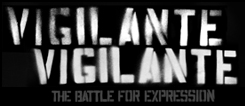News
Variety Reviews Vigilante Vigilante
http://www.variety.com/review/VE1117945779/
By Dennis Harvey
“We have met the enemy and he is us” said Walt Kelly’s comicstrip character Pogo 40 years ago, a phrase that might apply to the fanatical graffiti-abatement citizens in “Vigilante, Vigilante.” Max Good’s film touches on larger issues around free expression and blight while focusing on three individuals who’ve taken their opposition toward taggers to extremes that could be argued as unhealthy, unaesthetic, and/or unlawful. Engaging docu , in which the filmmakers themselves sometimes play a part, opens Aug. 12 at San Francisco’s Roxie Cinema, with modest further prospects likely to skew toward VOD.
A graffiti artist himself, Good argues the form democratizes blandly uniform or commercialized public surfaces by putting a personal, inherently agitating stamp on them. One foe, however, calls it an illegal “privatization of public spaces,” delivering messages (however indecipherable) the public is forced to witness without its consent.
The trio of middle-aged white men who are the film’s principal subjects consider themselves as performing a community service by wiping out graffiti in their geographically disparate environs. But it’s hard not to see their behavior as obsessive, at times creating more of a nuisance than the problem they’re addressing.
Garrulous Los Angeleno Joe “Graffiti Guerilla” Connelly considers himself engaged in a sort of friendly, sportive rivalry with the taggers whose work he habitually seeks and wipes out, even attending their occasional gallery openings — though they hardly feel the same way about him.
He’s happy to have the filmmakers along as an audience for his nonstop gab — unlike the docu’s other two main figures, “Gray Ghost” Fred Radtke, a New Orleans ex-Marine who’s gotten in trouble for painting out officially sanctioned artwork (and for physically menacing those who confront him), and Berkeley, Calif.’s “Silver Buff,” an elusive wee-hours “preservationist” (his term).
Good and producing partner Nathan Wollman stake out the Silver Buff, and discover him to be Jim Sharp, a man who not only sprays over graffiti but scrupulously removes flyers, stickers, private-lawn campaign signs and invasive weeds, among other things. Since his “corrective” moves can paint over a shop’s display-window or consign even a missing-child poster to the trash bin, many locals in the diehard liberal burg consider him an out-of-control nutcase. Good and Wollman enjoy harassing the taciturn Sharp, first saddling him with motor-mouthed Connelly as a visiting helper, then by painting over his silver erasures with their own more colorful spray-blots.
All three of the anti-graffiti subjects seem a tad crazy, their individual crusades working out some private pain we glimpse with variable clarity. Their solutions to graffiti as blight are indiscriminate and simple, but the docu doesn’t really wade into the gradations of what constitutes blight to different mindsets. Graffiti writers interviewed — many masked to protect their identity — disdain “amateur” tags while admiring work with boldly individual calligraphy or muralistic value. The voices of private-property owners, who figure to have the strongest legit objections to graffiti, are notably absent here.
Input from graffiti experts, academic theorists and others do add a sense of background and broader inquiry to what would otherwise be an entertaining but narrow portrait of a few contrarian personalities.
The outstanding element in often verite-rough package is Julien de Benedictus’ editing, which organizes the potentially unwieldy mix of materials cogently, and with nary a dull moment.







